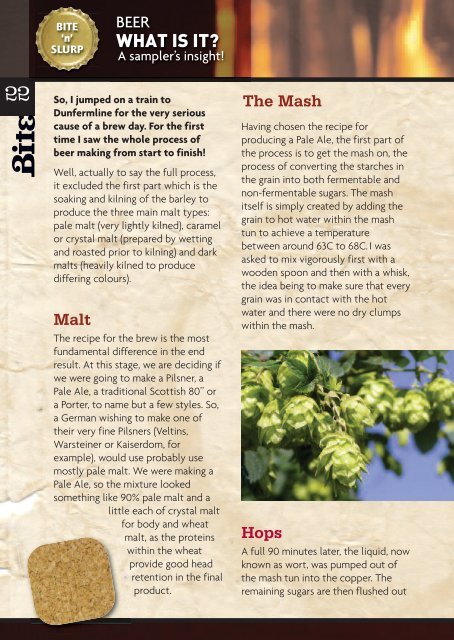Download July 2010 - Bite Magazine
Download July 2010 - Bite Magazine
Download July 2010 - Bite Magazine
You also want an ePaper? Increase the reach of your titles
YUMPU automatically turns print PDFs into web optimized ePapers that Google loves.
22<br />
BITE<br />
‘n’<br />
SLURP<br />
BEER<br />
WHAT IS IT?<br />
A sampler’s insight!<br />
So, I jumped on a train to<br />
Dunfermline for the very serious<br />
cause of a brew day. For the first<br />
time I saw the whole process of<br />
beer making from start to finish!<br />
Well, actually to say the full process,<br />
it excluded the first part which is the<br />
soaking and kilning of the barley to<br />
produce the three main malt types:<br />
pale malt (very lightly kilned), caramel<br />
or crystal malt (prepared by wetting<br />
and roasted prior to kilning) and dark<br />
malts (heavily kilned to produce<br />
differing colours).<br />
Malt<br />
The recipe for the brew is the most<br />
fundamental difference in the end<br />
result. At this stage, we are deciding if<br />
we were going to make a Pilsner, a<br />
Pale Ale, a traditional Scottish 80’’ or<br />
a Porter, to name but a few styles. So,<br />
a German wishing to make one of<br />
their very fine Pilsners (Veltins,<br />
Warsteiner or Kaiserdom, for<br />
example), would use probably use<br />
mostly pale malt. We were making a<br />
Pale Ale, so the mixture looked<br />
something like 90% pale malt and a<br />
little each of crystal malt<br />
for body and wheat<br />
malt, as the proteins<br />
within the wheat<br />
provide good head<br />
retention in the final<br />
product.<br />
The Mash<br />
Having chosen the recipe for<br />
producing a Pale Ale, the first part of<br />
the process is to get the mash on, the<br />
process of converting the starches in<br />
the grain into both fermentable and<br />
non-fermentable sugars. The mash<br />
itself is simply created by adding the<br />
grain to hot water within the mash<br />
tun to achieve a temperature<br />
between around 63C to 68C.I was<br />
asked to mix vigorously first with a<br />
wooden spoon and then with a whisk,<br />
the idea being to make sure that every<br />
grain was in contact with the hot<br />
water and there were no dry clumps<br />
within the mash.<br />
Hops<br />
A full 90 minutes later, the liquid, now<br />
known as wort, was pumped out of<br />
the mash tun into the copper. The<br />
remaining sugars are then flushed out




